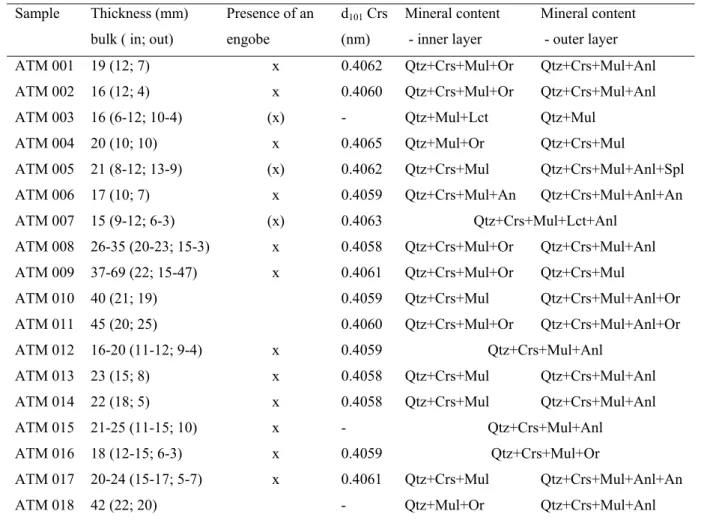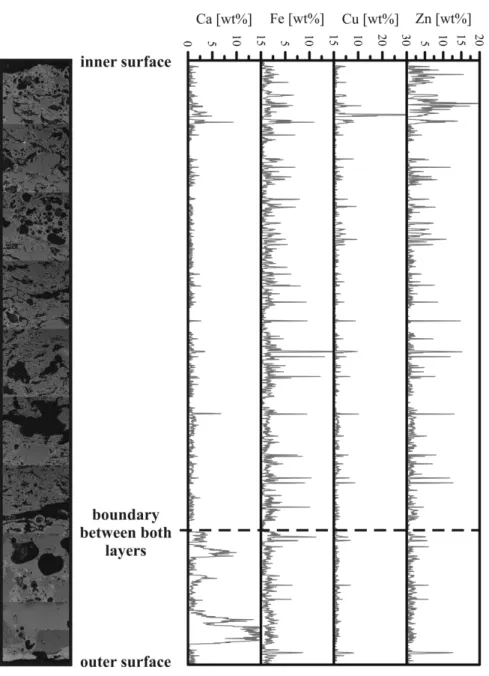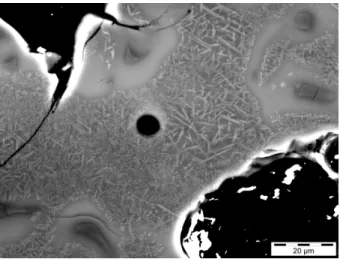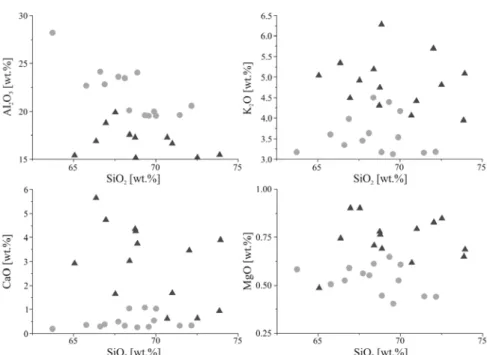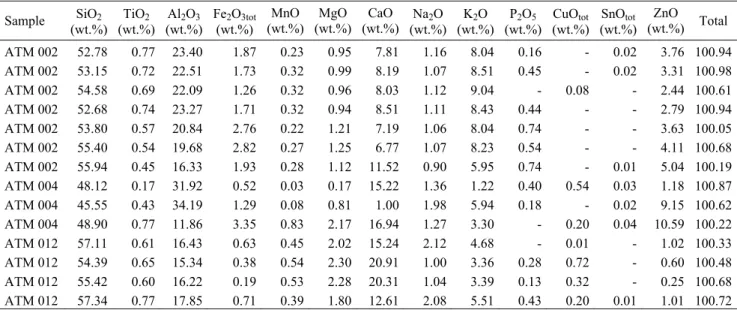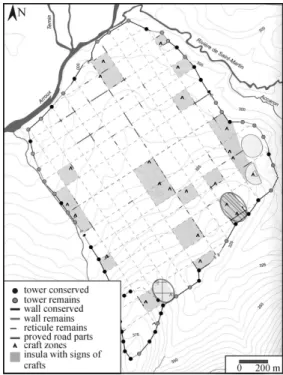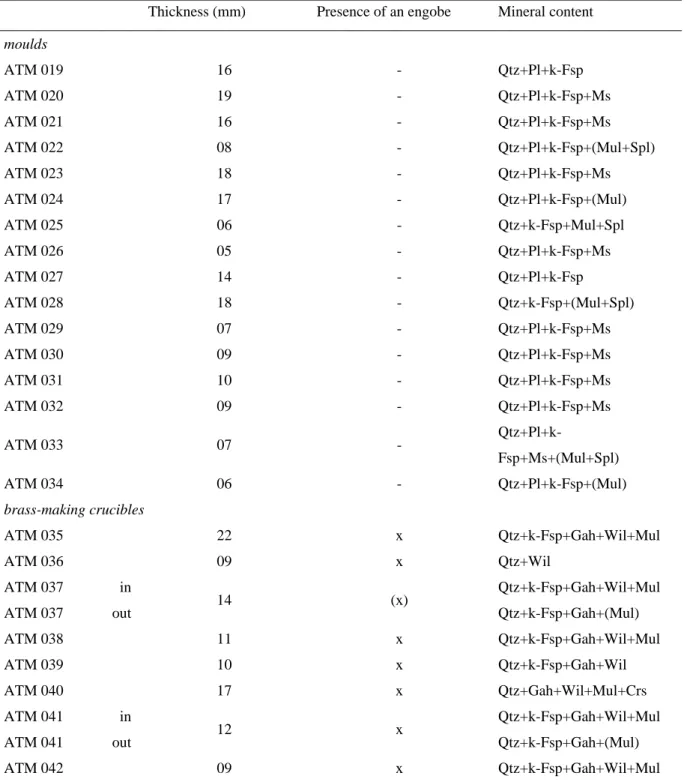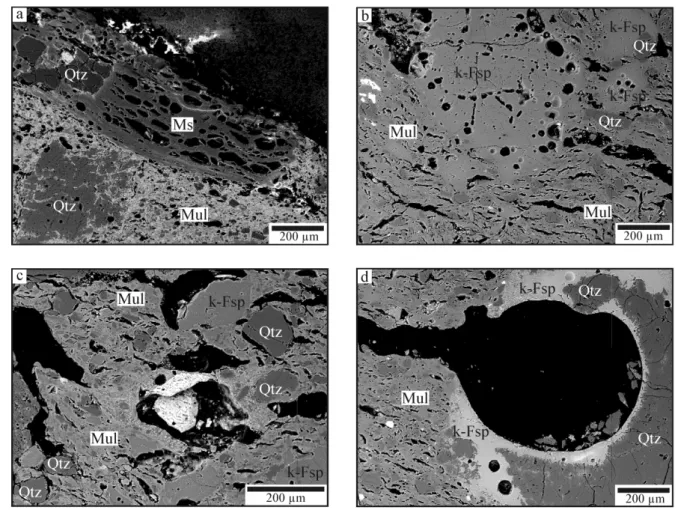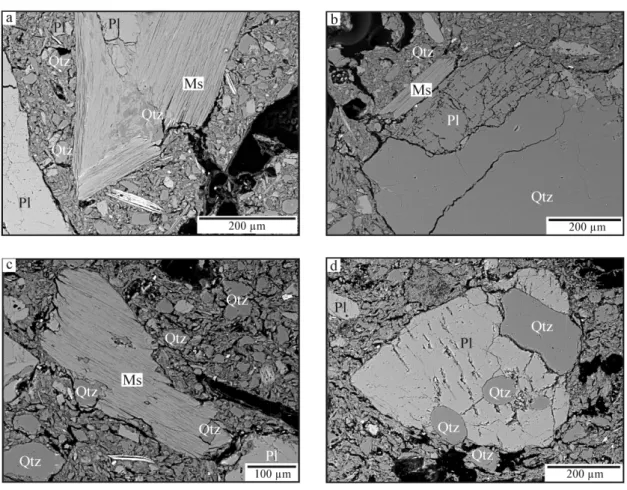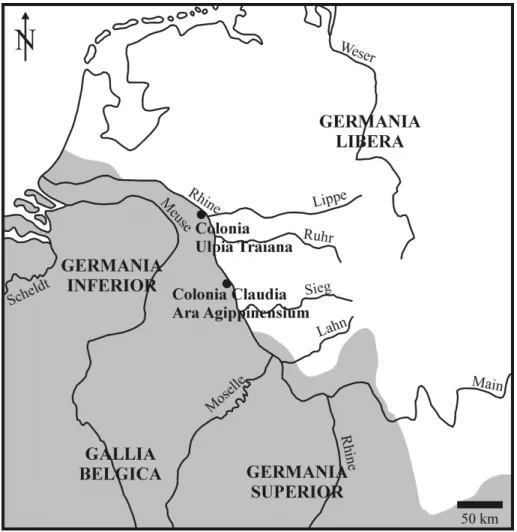GeoFocus
volume 36
GeoFocus is the publication series of the Department of Geosciences, University of Fribourg, Switzerland, and can be ordered at:
Department of Geosciences - Earth Sciences - University of Fribourg - 1700 Fribourg, Switzerland - http://www.unifr.ch/geoscience/geology Vol. 11 FREUDIGER-BONZON, Jeanne (2005) Archaeometrical study (petrography, mineralogy and chemistry) of Neolithic Ceramics from Arbon
Bleiche 3 (Canton of Thurgau, Switzerland) (187 pp.).
Vol. 12 STOFFEL, Markus (2005) Spatio-temporal variations of rockfall activity into forests - results from tree-ring and tree analysis (188 pp.). Vol. 13 RAMEIL, Niels (2005) Carbonate sedimentology, sequence stratigraphy, and cyclostratigraphy of the Tithonian in the Swiss and French
Jura Mountains - a high-resolution record of changes in sea level and climate (246 pp.).
Vol. 14 BRAILLARD, Luc (2006) Morphogenèse des vallées sèches du Jura tabulaire d’Ajoie (Suisse): rôle de la fracturation et étude des remplis-sages quaternaires (224 pp.).
Vol. 15 GOYETTE-PERNOT, Joëlle (2006) L’Ambroisie: analyse statistique et modélisation numérique de sa trajectoire aérobiologique (274 pp.). Vol. 16 TRESCH, Jonas (2007) History of a Middle Berriasian transgression (Switzerland, France, and southern England) (271 pp.).
Vol. 17 BONNET, Cécile (2007) Interactions between tectonics and surface processes in the Alpine foreland: Insights from analogue model and analysis of recent faulting (189 pp.).
Vol. 18 VONLANTHEN, Pierre (2007) EBSD-based investigations of upper mantle xenoliths, snowball garnets and advanced ceramics (114 pp.). Vol. 19 VÉDRINE, Stéphanie (2007) High-frequency palaeoenvironmental changes in mixed carbonate-siliciclastic sedimentary systems (Late
Oxfordian, Switzerland, France, and southern Germany) (216 pp.).
Vol. 20 BOLLSCHWEILER, Michelle (2008) Spatial and temporal occurrence of past debris flows in the Valais Alps - results from tree-ring analysis (182 pp.). Vol. 21 MARTY, Daniel (2008) Sedimentology, taphonomy, and ichnology of Late Jurassic dinosaur tracks from the Jura carbonate platform
(Chevenez-Combe Ronde tracksite, NW Switzerland): insights into the tidal-flat palaeoenvironment and dinosaur diversity, locomotion, and palaeoecology (278 pp.).
Vol. 22 STIENNE, Noémie (2010) Paléoécologie et taphonomie comparative en milieux carbonatés peu profonds (Oxfordien du Jura Suisse et Holocène du Belize) (248 pp.).
Vol. 23 WAITE, Richard (2010) The palaeoecology of high-spired gastropods and the lost palaeosols: depositional reconstructions on a shallow carbonate platform (Late Kimmeridgian, Swiss Jura Mountains) (149 pp.).
Vol. 24 MARGRET, Stephan (2010) Benthic foraminifera associated to cold-water coral ecosystems (248 pp.).
Vol. 25 VON ALLMEN, Katja (2010) Variations of calcium and barium isotopes and elemental contents in biogenic and abiogenic geological archives (97 pp.).
Vol. 26 VOUILLAMOZ, Naomi / SAUDAN, Corinne / MOSAR, Jon (2010) Microzonage sismique du canton de Fribourg - Cartographie au 1:25’000 des sols de fondation selon la norme SIA 261 (57 pp.).
Vol. 27 IBELE, Tobias, (2011) Tectonics of the Western Swiss Molasse Basin during Cenozoic Time (166 pp.).
Vol. 28 GENNARI, Giordana, (2011) The Mediterranean - Black Sea connections: The fundamental role of foraminifera as a multifaceted tool for the geological reconstruction of the last 10 ky (171 pp.).
Vol. 29 MORARD, Sébastien, (2011) Effets de la circulation d'air par effet de cheminée dans l'évolution du régime thermique des éboulis froids de basse et moyenne altitude (220 pp.).
Vol. 30 BOCHUD, Martin, (2011) Tectonics of the Eastern Greater Caucasus in Azerbaijan (201 pp.).
Vol. 31 MATZENAUER, Eva, (2012) Tectonics of the Préalpes Klippen and the Subalpine Molasse (Canton Fribourg, Switzerland) (207 pp.). Vol. 32 MENNECART, Bastien, (2012) The Ruminantia (Mammalia, Cetartiodactyla) from the Oligocene to the Early Miocene of Western Europe:
systematics, palaeoecology and palaeobiogeography (263 pp.).
Vol. 33 JARAMILLO-VOGEL, David, (2013) Shallow-marine sedimentary records of the Eocene–Oligocene greenhouse–icehouse transition (Italy, Switzerland and France) (182 pp.).
Vol. 34 TRITTSCHACK, Roy, (2013) Dehydroxylation kinetics of the serpentine group minerals (132 pp.).
Vol. 35 LAVOYER, Thibault, (2013) Paléontologie et stratigraphie de la partie nord du fossé rhénan supérieur moyen au cours du Paléogène : relations entre le système du rift, les transgressions marines et le paléoclimat (204 pp.).
ISSN 1424 - 1463
GeoFocus
volume 36
Daniela Kati
KÖNIG
(2014)
Daniela Kati KÖNIG
Roman metallurgical ceramics:
an archaeometrical approach
GeoFocus
volume 36
Already published:
GeoFocus is the publication series of the Department of Geosciences, University of Fribourg, Switzerland, and can be ordered at:
Department of Geosciences - Earth Sciences - University of Fribourg - 1700 Fribourg, Switzerland - http://www.unifr.ch/geoscience/geology Vol. 11 FREUDIGER-BONZON, Jeanne (2005) Archaeometrical study (petrography, mineralogy and chemistry) of Neolithic Ceramics from Arbon
Bleiche 3 (Canton of Thurgau, Switzerland) (187 pp.).
Vol. 12 STOFFEL, Markus (2005) Spatio-temporal variations of rockfall activity into forests - results from tree-ring and tree analysis (188 pp.). Vol. 13 RAMEIL, Niels (2005) Carbonate sedimentology, sequence stratigraphy, and cyclostratigraphy of the Tithonian in the Swiss and French
Jura Mountains - a high-resolution record of changes in sea level and climate (246 pp.).
Vol. 14 BRAILLARD, Luc (2006) Morphogenèse des vallées sèches du Jura tabulaire d’Ajoie (Suisse): rôle de la fracturation et étude des remplis-sages quaternaires (224 pp.).
Vol. 15 GOYETTE-PERNOT, Joëlle (2006) L’Ambroisie: analyse statistique et modélisation numérique de sa trajectoire aérobiologique (274 pp.). Vol. 16 TRESCH, Jonas (2007) History of a Middle Berriasian transgression (Switzerland, France, and southern England) (271 pp.).
Vol. 17 BONNET, Cécile (2007) Interactions between tectonics and surface processes in the Alpine foreland: Insights from analogue model and analysis of recent faulting (189 pp.).
Vol. 18 VONLANTHEN, Pierre (2007) EBSD-based investigations of upper mantle xenoliths, snowball garnets and advanced ceramics (114 pp.). Vol. 19 VÉDRINE, Stéphanie (2007) High-frequency palaeoenvironmental changes in mixed carbonate-siliciclastic sedimentary systems (Late
Oxfordian, Switzerland, France, and southern Germany) (216 pp.).
Vol. 20 BOLLSCHWEILER, Michelle (2008) Spatial and temporal occurrence of past debris flows in the Valais Alps - results from tree-ring analysis (182 pp.). Vol. 21 MARTY, Daniel (2008) Sedimentology, taphonomy, and ichnology of Late Jurassic dinosaur tracks from the Jura carbonate platform
(Chevenez-Combe Ronde tracksite, NW Switzerland): insights into the tidal-flat palaeoenvironment and dinosaur diversity, locomotion, and palaeoecology (278 pp.).
Vol. 22 STIENNE, Noémie (2010) Paléoécologie et taphonomie comparative en milieux carbonatés peu profonds (Oxfordien du Jura Suisse et Holocène du Belize) (248 pp.).
Vol. 23 WAITE, Richard (2010) The palaeoecology of high-spired gastropods and the lost palaeosols: depositional reconstructions on a shallow carbonate platform (Late Kimmeridgian, Swiss Jura Mountains) (149 pp.).
Vol. 24 MARGRET, Stephan (2010) Benthic foraminifera associated to cold-water coral ecosystems (248 pp.).
Vol. 25 VON ALLMEN, Katja (2010) Variations of calcium and barium isotopes and elemental contents in biogenic and abiogenic geological archives (97 pp.).
Vol. 26 VOUILLAMOZ, Naomi / SAUDAN, Corinne / MOSAR, Jon (2010) Microzonage sismique du canton de Fribourg - Cartographie au 1:25’000 des sols de fondation selon la norme SIA 261 (57 pp.).
Vol. 27 IBELE, Tobias, (2011) Tectonics of the Western Swiss Molasse Basin during Cenozoic Time (166 pp.).
Vol. 28 GENNARI, Giordana, (2011) The Mediterranean - Black Sea connections: The fundamental role of foraminifera as a multifaceted tool for the geological reconstruction of the last 10 ky (171 pp.).
Vol. 29 MORARD, Sébastien, (2011) Effets de la circulation d'air par effet de cheminée dans l'évolution du régime thermique des éboulis froids de basse et moyenne altitude (220 pp.).
Vol. 30 BOCHUD, Martin, (2011) Tectonics of the Eastern Greater Caucasus in Azerbaijan (201 pp.).
Vol. 31 MATZENAUER, Eva, (2012) Tectonics of the Préalpes Klippen and the Subalpine Molasse (Canton Fribourg, Switzerland) (207 pp.). Vol. 32 MENNECART, Bastien, (2012) The Ruminantia (Mammalia, Cetartiodactyla) from the Oligocene to the Early Miocene of Western Europe:
systematics, palaeoecology and palaeobiogeography (263 pp.).
Vol. 33 JARAMILLO-VOGEL, David, (2013) Shallow-marine sedimentary records of the Eocene–Oligocene greenhouse–icehouse transition (Italy, Switzerland and France) (182 pp.).
Vol. 34 TRITTSCHACK, Roy, (2013) Dehydroxylation kinetics of the serpentine group minerals (132 pp.).
Vol. 35 LAVOYER, Thibault, (2013) Paléontologie et stratigraphie de la partie nord du fossé rhénan supérieur moyen au cours du Paléogène : relations entre le système du rift, les transgressions marines et le paléoclimat (204 pp.).
ISSN 1424 - 1463
GeoFocus
volume 36
Daniela Kati
KÖNIG
(2014)
Daniela Kati KÖNIG
Roman metallurgical ceramics:
an archaeometrical approach
GeoFocus is the publication series of the Department of Geosciences, University of Fribourg, Switzerland, and can be ordered at:
Department of Geosciences - Earth Sciences - University of Fribourg - 1700 Fribourg, Switzerland - http://www.unifr.ch/geoscience/geology Vol. 1 HILLGÄRTNER, Heiko (1999) The evolution of the French Jura platform during the Late Berriasian to Early Valanginian: controlling
factors and timing (203 pp.).
Vol. 2 DUPRAZ, Christophe (1999) Paléontologie, paléoécologie et évolution des faciès récifaux de l’Oxfordien Moyen-Supérieur (Jura suisse
et français) (247 pp.).
Vol. 3 BASSANT, Philip (1999) The high-resolution stratigraphic architecture and evolution of the Burdigalian carbonate-siliciclastic
sedimen-tary systems of the Mut Basin, Turkey (278 pp.).
Vol. 4 COLOMBIÉ, Claude (2002) Sédimentologie, stratigraphie séquentielle et cyclostratigraphie du Kimméridgien du Jura suisse et du Bassin
vocontien (France): relations plate-forme - bassin et facteurs déterminants (198 pp.).
Vol. 5 PICOT, Laurent (2002) Le Paléogène des synclinaux du Jura et de la bordure sud-rhénane: paléontologie (Ostracodes), paléoécologie,
biostratigraphie et paléogéographie (240 pp.).
Vol. 6 DAPPLES, Florence (2002) Instabilités de terrain dans les Préalpes fribourgeoises (Suisse) au cours du Tardiglaciaire et de l’Holocène:
influence des changements climatiques, des fluctuations de la végétation et de l’activité humaine (158 pp.).
Vol. 7 HUG, Wolfgang Alexander (2003) Sequenzielle Faziesentwicklung der Karbonatplattform des Schweizer Jura im Späten Oxford und
frühesten Kimmeridge (156 pp.).
Vol. 8 OSWALD, Daniel (2003) Analyse de l’activité de glissements de terrain et relation avec les conditions climatiques: Exemples dans les
Préalpes fribourgeoises (Suisse) (147 pp.).
Vol. 9 BECKER, Damien (2003) Paléoécologie et paléoclimats de la Molasse du Jura (Oligo-Miocène): apport des Rhinocerotoidea (Mammalia)
et des minéraux argileux (327 pp.).
Aus dem Departement für Geowissenschaften
Universität Freiburg (Schweiz)
Roman metallurgical ceramics: an archaeometrical approach
INAUGURAL-DISSERTATION
zur Erlangung der Würde eines Doctor rerum naturalium
der Mathematisch-Naturwissenschaftlichen Fakultät
der Universität Freiburg in der Schweiz
vorgelegt von
Daniela Kati König
aus
Markkleeberg, Deutschland
These N° 1832
2014
Contents - i
C
ONTENTS
ABSTRACT ... 1 ZUSAMMENFASSUNG ... 3 ACKNOWLEDGEMENTS ... 5 ABBREVIATION LIST ... 6 1. INTRODUCTION 7 1.1. RESEARCH BACKGROUND ... 7 1.2. GOALS ... 8 2. EXPERIMENTAL METHODS 92.1. SCANNING ELECTRON MICROSCOPY (SEM) ... 9
2.2. MICROPROBE ... 10
2.3. X-RAY DIFFRACTION ... 10
2.4. PORTABLE X-RAY DIFFRACTION (CONTRIBUTION:M.HELFERT) ... 10
2.5. X-RAY FLUORESCENCE... 11
2.6. THERMOGRAVIMETRIC ANALYSES (TGA) ... 11
2.7. RAMAN-SPECTROSCOPY ... 12
3. ROMAN DOUBLE-LAYERED CRUCIBLES FROM AUTUN/FRANCE: A PETROGRAPHICAL AND GEOCHEMICAL APPROACH 13
ABSTRACT ... 13
3.1. INTRODUCTION ... 13
3.2. DOUBLE-LAYERED CRUCIBLES FROM AUTUN ... 14
3.3. RESULTS AND DISCUSSION ... 15
3.3.1. Geochemical and mineralogical characterisation of the two main layers ... 16
3.3.2. The engobe as a kind of inner protecting layer ... 24
3.3.3. Multiple usages ... 25
3.3.4. Estimation of firing temperatures ... 26
4. A PETROGRAPHICAL AND GEOCHEMICAL CHARACTERISATION OF ROMAN MOULDS AND BRASS
-MAKING CRUCIBLES FROM AUTUN/FRANCE 29
ABSTRACT ... 29
4.1. INTRODUCTION ... 29
4.2. BRASS-MAKING CRUCIBLES AND MOULDS FROM AUTUN/FRANCE ... 30
4.3. BRASS-MAKING CRUCIBLES ... 33
4.4. LOST-WAX MOULDS ... 36
4.5. COMPARISON BETWEEN THE THREE MAIN TYPES OF COPPER-ALLOY RELATED CERAMICS FROM AUTUN ... 37
4.5.1. Structure of the investigated ceramic types ... 37
4.5.2. Chemical composition of the investigated ceramic types ... 39
4.6. CONCLUSION ... 44
5. AN ANALYTICAL STUDY OF ROMAN CRUCIBLES FROM XANTEN/GERMANY 48
ABSTRACT ... 48
5.1. INTRODUCTION ... 48
5.1.1. Historical background ... 49
5.1.2. Sample material ... 50
5.2. RESULTS AND DISCUSSION ... 51
5.3. CONCLUSIONS ... 56
6. ROMAN CRUCIBLES FROM AUGUSTA RAURICA (AUGST/SWITZERLAND) – AN INTERDISCIPLINARY APPROACH USING BOTH LABORATORY AND PORTABLE ANALYSES 57
ABSTRACT ... 57
6.1. INTRODUCTION ... 57
6.1.1. The site of Augusta Raurica and the evidence of its bronze working ... 57
6.1.2. Material analysed and sample selection ... 58
6.1.3. Shape, size and dating of the crucibles ... 58
6.1.4. Questions dealt with in this paper ... 60
6.2. RESULTS AND DISCUSSION ... 61
6.2.1. Petrographic characteristics of the crucibles studied ... 61
6.2.2. Requirements and types of crucible clay ... 67
6.2.3. Origins of the crucible clay ... 68
6.2.4. Firing temperatures ... 71
6.2.5. Crucibles in metallurgical melting processes ... 72
Contents - iii
7. COMPARISON OF ROMAN METAL-MELTING CRUCIBLES FROM AUTUN/FRANCE,
AUGST/SWITZERLAND,AVENCHES/SWITZERLAND AND XANTEN/GERMANY 75
ABSTRACT ... 75
7.1. INTRODUCTION ... 75
7.1.1. Historical background ... 76
7.2. RESULTS AND DISCUSSION ... 78
7.2.1. Shape ... 78
7.2.2. Structure ... 78
7.2.3. Petrographical and mineralogical properties ... 80
7.2.4. Firing temperatures ... 82
7.3. CONCLUSION ... 84
8. KERAMISCHE PROBEN AUS DER AUSGRABUNG MARSENS EN BARRAS 1981/86 89
ZUSAMMENFASSUNG ... 89
ABSTRACT ... 89
8.1. MARSENS EN BARRAS ... 89
8.2. MAKROSKOPISCHE ANSPRACHE ... 90
8.3. ERGEBNISSE DER MATERIALANALYSEN ... 90
8.3.1. Lichtmikroskopie ... 90 8.3.2. Rasterelektronenmikroskopie (REM)... 92 8.3.3. Röntgenpulverdiffraktion (RPD) ... 94 8.3.4. Röntgenfluoreszenzanalyse (RFA) ... 95 8.4. INTERPRETATION ... 96 8.5. SCHLUSSFOLGERUNG ... 99
9. CONCLUSIONS AND PERSPECTIVES 100
APPENDIX I-Petrographische und geochemische Beschreibung römischer Schmelztiegel in Bezug auf Vergleichbarkeit und Tonherkunft ... 102
APPENDIX II-Table about methods performed per sample ... 125
APPENDIX III-Metal prill investigations ... 130
APPENDIX IV-List of XRF-investigations ... 132
REFERENCES ... 140
Abstract - 1
A
BSTRACT
This Ph.D. thesis focuses on technical ceramics, i.e., copper-alloy related metal-melting crucibles, brass-making crucibles and lost-wax moulds from five different excavation sites in Central and Western Europe dating to the Roman period. An archaeometrical approach using analytical techniques from the field of Earth Sciences was used in order to gain information about the production routine, i.e., used materials like clay, temper and non-plastic inclusions, firing temperature, number of use etc. as well as information on trading relations and exchange of technological knowledge. For this, 18 metal-melting crucibles, eight brass-making crucibles and 16 mould fragments from Autun/France were studied by using petrographical (optical microscopy), elemental (SEM-EDS, EMPA, XRF-WDS) and mineralogical (XRD) techniques. Additionally, 15 metal-melting crucible fragments from Augst/Switzerland and ten metal-melting vessels from Avenches/Switzerland were compared concerning their macroscopic attributes (shape, size etc.), geochemical and mineralogical properties. Trading relations between both Roman towns were assayed based on the crucibles characteristics. Moreover, eight metal-melting crucible fragments from Xanten/ Germany were investigated in a similar manner and compared with the ones from the aforementioned excavation.
A single set of technical ceramics composed of five metal-melting crucibles, three fragments of oven-walls, one “Bouchon” used for preparation of sculptures and nine ceramic samples with unclear relation to its origin coming from an excavation in Marsens En Barras/Switzerland was also
analysed based on mineralogical criteria. But, they have not been compared with fragments of other localities due their own characteristics.
This thesis consists of six stand-alone articles which are either published, accepted for publication, under review or ready for submission.
The first paper (Chapter 3) deals with Roman metal-melting crucibles from Autun/France. The 18 vessel fragments show a double-layered structure, i.e., a non-vitrified ceramic inner layer and most often a strongly vitrified outer layer. In addition to these layers there is an innermost vitrified engobe observable in almost all fragments studied. These crucibles are relatively large in size with a maximum capacity of around 19 kg of metal charge. Estimated (maximum) firing temperatures of single fragments point to a maximum of 1400 °C.
The second article (Chapter 4) describes eight fragments of brass-making crucibles from the Rue Bouteiller (Autun/France) and sixteen lost-wax moulds fragments from the Lycee Militaire (Autun/France) concerning their structure (number of layers) and geochemical/ mineralogical composition. Whereas brass-making crucibles are building up of a main non-vitrified ceramic body with an occurring non-vitrified engobe and an additional non-vitrified outer layer for fixing the lid, moulds consist of one main ceramic body with a very fine ceramic cover, which formerly was in direct contact to the metal artefact itself. All acquired data indicate common clay and temper material used for brass-making crucibles and moulds from Autun/France. The clay and temper material used for this kind of
technical ceramic is the same used for the metal-melting crucibles in Autun/France.
The third paper (Chapter 5) delineates eight metal-melting crucible fragments from Xanten/Germany concerning their overall structure and geochemical/mineralogical composition. These vessels are also double-layered with a non-vitrified inner layer, a vitrified outer layer and an occurring vitrified engobe in some cases. These crucibles are much smaller than the ones from Autun/France. They show a volumetric capacity of a maximum of 1.5 kg. Estimated firing temperatures reach a maximum of 1100 °C.
Paper four (Chapter 6) focuses on Roman metal-melting crucibles from two Swiss excavation sites within the former Roman settlements Augusta Raurica (15 samples) and Aventicum (ten samples). The investigated set of samples were analysed in the same way as those of Autun/France and Xanten/Germany and additionally characterised by portable-XRF analyses. The data serve as a base for a comparison with other metal-melting crucibles examined in this Ph.D. thesis. This article describes not only the structure and mineralogical properties of these vessels which are similar to the ones from Autun/France and Xanten/Germany, but tries to gain information about clay sources and possible trading activities regarding the crucibles between both Roman settlements only or an unknown locality in addition.
Appendix 1 (in German) is connected to the aforementioned chapter as it is a more detailed description of metal-melting crucibles from Augst/Switzerland and Avenches/Switzerland. This article discusses in detail the clay composition, estimated firing temperatures as well as indications for trading of crucibles between former Roman settlements in Switzerland. This article contains clearly displayed contributions of Alex R. Furger .
The fifth publication (Chapter 7) was done to assemble differences and communalities in terms of surface and shape properties, petrographical and mineralogical properties and their interpretation between the individual sets of Roman metal-melting crucibles discussed in chapters 3, 5 and 6. This work tries to verify the hypothesis of a common recipe to produce metal-melting crucibles within the Roman Empire, at least valid for the sites studied within Central and Western Europe.
The last chapter (Chapter 8) is only a part of an archaeological excavation report which is made on different ceramic samples (five metal-melting crucibles, three fragments of oven-walls, one “Bouchon” and nine ceramic samples with unclear relation to its origin) from Marsens En Barras/Switzerland. The samples derive from a very small-scaled copper-alloy manufacturing site within a small Roman settlement with a specialisation in iron manufacturing. The metal-melting crucibles are made of a single layer with a ceramic inside and a vitrified outside. They are thus not compatible with other Roman crucibles investigated within this Ph.D. thesis. The ceramic is made of non-refractory clay coming from the Molasse sediments and partially contain organic temper.
Zusammenfassung - 3
Z
USAMMENFASSUNG
Die vorliegende Doktorarbeit beschäftigt sich mit technischen Keramiken aus fünf verschiedenen archäologischen Ausgrabungen in West- und Zentraleuropa. Diese technischen Keramiken umfassen Schmelztiegel für Kupferlegierungen, Zementationstiegel für die Herstellung von Messing und Abgussformen. Wesentliche Fragen beziehen sich auf: (1) den Herstellungsprozess bezogen auf verwendetes Material, Brenntemperaturen, Anzahl der Nutzung einzelner Tiegel, usw.; (2) den Wissensaustausch zwischen unterschiedlichen römischen Siedlungen und Städten; (3) den möglichen Handel von Schmelztiegeln zwischen unterschiedlichen Städten beziehungsweise Fabrikationsorten und den Städten.
Die 18 Schmelztiegel, acht Zementations-tiegel und 16 Fragmente von Abgussformen aus Autun/Frankreich wurden bezüglich ihrer petrographischen (Mikroskopie), geochemischen (REM-EDS, EMS, RFA-WDS) und mineralogischen (RPD) Eigenschaften hin untersucht. Zusätzlich wurden 15 Schmelztiegelfragmente aus Augst/Schweiz und zehn Schmelztiegelbruchstücke aus Avenches/ Schweiz hinsichtlich optischer Eigenschaften (z.B. Form, Größe, etc.), geochemischer und mineralogischer Eigenschaften, sowie dem Handel von Schmelztiegeln verglichen. Außerdem wurden acht Schmelztiegel-bruchstücke aus Xanten/Deutschland in der gleichen Weise analysiert und den anderen Schmelztiegeln gegenübergestellt. Zudem wurden fünf Schmelztiegelfragmente, drei Bruchstücke von Ofenwandungen, ein „Bouchon“, welcher für die Herstellung von Plastiken verwendet wurde, und neun nicht
eindeutig zugeordnete keramische Probenstücke aus Marsens En Barras/Schweiz untersucht. Diese wurden jedoch nicht mit den anderen analysierten technischen Keramiken verglichen.
Diese Arbeit besteht aus sieben einzelnen Artikeln, welche entweder bereits publiziert oder für die Publikation akzeptiert wurden, beziehungsweise sich gerade unter Begutachtung bei Fachzeitschriften befinden oder für die Eingabe bei einer Zeitschrift bereit sind.
Der erste Artikel (Kapitel 3) beschäftigt sich mit Schmelztiegeln aus Autun/Frankreich. Die 18 Tiegelbruchstücke zeigen einen zwei-lagigen Aufbau mit einer nicht verglasten inneren Lage und einer mehr oder minder gut verglasten äußeren Lage. Zusätzlich ist eine verglaste Engobe in den meisten Fragmenten zu finden. Die Schmelztiegel sind mit einer Metallkapazität von 19 kg relativ groß. Ermittelte Brenntemperaturen erreichen ein Maximum von 1400 °C.
Die zweite Publikation (Kapitel 4) beschreibt Zementationstiegel und Abgussformen aus Autun/Frankreich hinsichtlich ihrer Struktur (z.B. Anzahl der keramischen Lagen) und geochemischen/ mineralogischen Zusammen-setzung. Die Zementationstiegel bestehen aus einer nicht verglasten keramischen Lage mit einer Engobe und einer im oberen Drittel auftretenden äußeren nicht verglasten Lage, die zur Abdichtung von Tiegel und Deckel verwendet wurde. Hingegen bestehen die Abgussformen aus einem nicht verglasten keramischen Körper der im direkten Kontakt mit dem Metall einen feinen Tonüberzug aufweist. Der Ausgangston und die zugegebene Magerung in diesen beiden Keramiken ist der gleiche wie der, der für die Schmelztiegel
von Autun/Frankreich Verwendung fand. Die drei Typen von technischen Keramiken aus Autun/ Frankreich werden hinsichtlich ihrer nach-gewiesenen Eigenschaften miteinander verglichen.
Artikel drei (Kapitel 5) befasst sich mit Schmelztiegeln aus Xanten/Deutschland bezogen auf deren Struktur und geochemisch-mineralogische Zusammensetzung. Alle Tiegel sind zweilagig aufgebaut, wobei die innere Lage nicht verglast und die äußere Lage vollständig verglast ist. Allen Proben gemein ist eine innere Engobe. Die Schmelztiegel sind mit einer Metallkapazität von 1,5 kg deutlich kleiner als die aus Autun/ Frankreich stammenden. Die mineralogischen Befunde deuten auf geringere maximale Brenn-temperaturen (rund 1100 °C) hin.
Mit römischen Schmelztiegeln aus zwei Ausgrabungen in der Schweiz (Augusta Raurica und Aventicum) beschäftigt sich der vierte Bericht (Kapitel 6). Bruchstücke beider Ausgrabungen wurden hinsichtlich ihrer Vergleichbarkeit der Analyseergebnisse sowohl untereinander, als auch mit den zuvor beschriebenen Schmelztiegeln untersucht. Chemische Daten die mittels portabler RFA Analyse erhoben wurden, ergänzen die geochemischen Labor-untersuchungen. Dieser Bericht befasst sich nicht ausschließlich mit der Struktur der Tiegel, welche mit denen aus Autun/Frankreich und Xanten/Deutschland vergleichbar ist, sondern auch mit der Tonherkunft und möglichem Handel von Schmelztiegeln zwischen beiden römischen Städten respektive möglichem Handel zwischen einem unbekannten Produktionsort und den beiden römischen Städten.
Im Appendix I findet sich ein weiterer in deutscher Sprache verfasster Aufsatz über die Proben aus Augst und Avenches (beide: Schweiz). Der Bericht befasst sich ausschließlich mit den gefundenen Schmelztiegeln in Bezug auf deren Tonzusammensetzung, Aufbau, Form und
Brenntemperaturen als auch mit dem Handel der Tiegel.
Der Vergleich zwischen den in Artikel eins bis vier untersuchten Schmelztiegeln wird in der fünften Publikation (Kapitel 7) bezüglich ihrer Form, Aufbau, petrographischen und geochemischen Zusammensetzung hin betrachtet. Diese Arbeit versucht ein allgemeingültiges Rezept für römische Schmelztiegel zumindest für die untersuchten Standorte in Zentraleuropa aufzuzeigen und zu erörtern.
Bei dem letzten Kapitel (Kapitel 8) handelt es sich um einen Teilbericht für eine archäologische Publikation im Rahmen der Ausgrabung Marsens En Barras/Schweiz. Die Proben stammen aus einer kleinmaßstäblichen Kupfer verarbeitenden Werkstatt, in deren Umfeld in großem Maßstab Eisen verarbeitet wurde. Die untersuchten Schmelztiegel sind verglichen mit den anderen nicht eindeutig zweilagig. Sie zeigen zwar unterschiedliche Eigenschaften bezüglicher der Verglasung (innen - nicht verglast, außen - verglast), jedoch sind diese beiden Bereiche in keinem der untersuchten Fragmente voneinander trennbar. Der verwendete Ton entstammt den lokalen Molassevorkommen und weist eine geringe thermische Stabilität auf. Zusätzlich treten organische Magerungsbestandteile auf, welche in keiner sonstigen, der im Rahmen dieser Dissertation untersuchten, technischen Keramiken auftreten.
Acknowledgements - 5
A
CKNOWLEDGEMENTS
I would like to thank all the people who helped me during the last four years of my Ph.D. thesis.
First of all, I would like to express my deep gratitude to Prof. Vincent Serneels, my research supervisor, for his patient guidance, enthusiastic encouragement and useful critiques of this research work.
Special thanks go to Prof. Bernard Grobéty and Prof. Marino Maggetti (both University of Fribourg/Switzerland) for their helpful suggestions and discussions. I thank Mr. Christoph Neururer (University of Fribourg/Switzerland) for his technical support, Mr. Jean-Paul Bourqui and Mr. Patrick Dietsché for the sample preparation. My grateful thanks are also extended to Dr. Martin Robyr (University of Bern/Switzerland) for the EMPA support and Dr. Eric Reusser (ETH Zurich/Switzerland) for the Raman support.
I also express gratitude to Mr. Alex R. Furger (Augusta Raurica/Switzerland) and Dr. Markus Helfert (University Frankfurt a. M./Germany) for their fruitful discussions about metal-melting crucibles and with the portable XRF analyses of the samples from Augst/Switzerland. And many thanks Alex for providing the sample material from Augusta Raurica and Mrs. Marie-France Meylan-Krause (Avenches/Switzerland) to provide the samples from Aventicum.
Many thanks go to Dr. Bernd Liesen (LVR-Archaeological Park Xanten/Germany) who makes the samples from Colonia Ulpia Traiana available for my studies.
I furthermore thank Dr. Yannick Labaune (Autun/France) for providing the ceramic samples from Augustodunum.
Thanks to all my friends and colleagues at the Department of Geosciences in Fribourg, you made the last four years to a delightful and pleasant experience: André, Andres, Anna, Anneleen, Bastien, Cédric, Claudio, Claudius, Daniel, David, Eva, Flavius, Florent, Giordana, Gisela, Ildiko, Jean-Pierre, Juanita, Jon, Luc, Maëlle, Mario, Marius, Martin, Martinus, Monica, Naomi, Raphaëlle, Silvia, Thibault, Tobias. I would like to thank Nicole Brugger for her pleasant way to help me in administrative issues.
I would also like to thank my mother for the support she provided me through my entire life and in particular, I must acknowledge my little son Leonard Richard and my husband and best friend, Roy, without whose love, encouragement and editing assistance, I would not have finished this thesis.
A
BBREVIATION LIST
°C degree Celsius
A.D. Anno Domini
BSE backscattered electron(s) B.C. Before Christ
ca. circa
cm centimetre(s) cm-1 wavenumber units
e.g. exempli gratia/ for example EDS energy dispersive X-Ray
spectroscopy
EMPA Electron microprobe analysis et al. et alii/ and others
etc. et cetera/ and more FEG field emission gun
g Gramm/gramme Gew.% Gewichtsprozent in prep. in preparation
i.e. id est/ that means kg kilograms km kilometre(s) kV kilovolt L litre(s) LVR Landschaftsverband Rheinland m metre(s) M. Massstab mA milliampere mg milligram(s) min minute(s) ml millilitre(s) mm millimetre(s) ms millisecond(s) mW milliwatt µl microlitre(s) µm micrometre(s) nA nanoampere n. Chr. nach Christus nm nanometre(s) Ph.D. Doctor of Philosophy ppm part per million
p-XRF portable X-ray fluorescence analysis REM Rasterelektronenmikroskop(ie) RPD Röntgenpulverdiffraktometrie SE secondary electron(s) s second(s)
SEM scanning electron microscop(e/y) vol.% volume percent
vs. versus
XRD X-ray diffraction analysis XRF X-ray fluorescence analysis XRPD X-ray powder diffraction analysis WDS wavelength dispersive X-ray
spectroscopy
wt.% weight percent
Further/ special characters and abbreviations are indicated in the respective chapters of this Ph.D. thesis.
Introduction - 7
1
-
I
NTRODUCTION
1.1
R
ESEARCH BACKGROUNDIn general, technical ceramics are defined as ceramics which exhibits a high degree of industrial efficiency due to their carefully designed microstructure. Technical ceramics including principally ceramics with superior mechanical properties such as great strength, a high level of elasticity, enhanced hardness, hest resistance and abrasion resistance (Somiya 1989). The term technical ceramic is a designation for ceramics used in ‘industrial’ applications like, e.g. crucibles or moulds, which are discussed in more detail below.
Crucibles, in general, and moulds are important artefacts to receive detailed technological and metallurgical knowledge about specific metalworking areas (Tite et al. 1985, Nielen 2006). Thus, there exists a specific interest to study such artefacts by a series of modern analytical techniques usually used in Material Sciences in order to obtain a comprehensive knowledge about the artefacts and to compare artefacts coming from different excavation sites with each other.
In archeometry, it is usual to differentiate functional categories of crucibles which are considered to be main processes, i.e., melting and cementation (Bayley and Rehren 2007). The nature of these processes determines fundamentally the vessel form and the ceramic fabric (Rehren 2003). Metal-melting vessels are the most frequent type (Bayley and Rehren 2007). It was essential to design them small but strong in order to guarantee easy handling of such crucibles. Furthermore, such a handling requires a fabric which ensures mechanical stability at temperatures well above 1000 °C (Bayley 1992, Bayley and Rehren 2007).
Correspondingly, the volume was frequently limited to a maximum of one litre of liquid metal, but often much less prior to the Industrial Revolution (Bayley 1992, Bayley and Rehren 2007). Nevertheless, there are exceptions of these limitations as reported from the excavation of Autun/France (König and Serneels 2013).
Cementation crucibles were considered for the reaction of solids (e.g., metal, ore etc.) with a vapour phase, which requires carefully controlled temperatures and atmospheres to guarantee that the vapour phase stays in contact with the other ingredients (Bayley and Rehren 2007). Brass-making crucibles are a certain kind of cementation crucibles with explicit and diagnostic features like poorly refractory fabrics, particular during the Roman period, and the high level of zinc detectable in all of them (Martinon-Torres and Rehren 2002). These kinds of crucibles are usually small in size (Bayley 1984, Rehren 1999) as this was favourable for the energy balance of the process (Bayley and Rehren 2007). The crucibles have to be a kind of closed vessel. As the fabric is not sufficiently porous, a small opening is essential to relieve any build-up of pressure (Bayley and Rehren 2007). In order to maximise the ratio of surface area (heat input) to volume (heat use), these crucibles are usually small and/or tubular rather than spherical in shape (Bayley and Rehren 2007). In general, an increased production caused a higher number of vessels used, rather than increasing the size of individual vessels (Rehren 1999). Again, there are some exceptions of such a general rule as demonstrated in a Roman excavation near Lyon/France and Autun/France (Picon et al. 1995, Chardron-Picault and Picon 1997).
Cast objects like fibulae were made by melting metal in a crucible and pouring it into a mould, where it became solid. For the Roman period, two types of moulds are known, i.e., investment and piece moulds. Investment moulds were prepared by the lost-wax technique and destroyed after use. These kinds of moulds were made of clay (Bayley and Butcher 2004), i.e., without any specific constraints regarding temperature stability. Piece moulds consist of two or more individual pieces and were either made of stone but clay also. Such moulds can usually be reused. But, piece moulds of clay are as much destroyed as investment moulds. For Roman finds in Britain, Bayley and Butcher (2004) describe mainly piece moulds for casting single fibulae or brooches. They also describe continental finds, e.g., from Autun/France (Chardron-Picault and Pernot 1999) and Nandin/France (Marquart 1935), for which they imply a simultaneous casting of two or more fibulae within one mould. This suggests assembling of individual clay moulds to multiples before casting (Beck et al. 1982/3).
1.2
G
OALSThe goal of this Ph.D. thesis is the result of open questions concerning Roman technical ceramics especially Roman metal-melting crucibles and exceptionally large brass-making crucibles from Autun/France. Most descriptions of Roman crucibles in literature focus on archaeological important properties only, i.e., shape, size, decoration patterns, colours etc. Thus, only less is known about (distinct) material properties, i.e., number of individual layers distinguishable by their mineralogical characteristics, composition of temper and non-plastic inclusions allowing among others to reconstruct certain preparation techniques, element content present within individual layers helpful for the determination of a clay source, occurrence of temperature specific mineral phases useful for reconstructing ancient firing temperatures,
composition of metal remnants etc. It is clear that not all open questions can be answered during the timeframe of a single thesis, but this study shall serve to create a basis for material properties of Roman metal-melting crucibles by answering questions related to the aforementioned set of issues, i.e., collecting information about used raw materials, the production routine and the recipes for making metal-melting crucibles. Therefore, the thesis is subdivided into six single papers and/or contributions of publications, respectively, which discuss mainly following issues:
The characterisation of Roman metal-melting crucibles, brass-making crucibles and moulds concerning their overall structure, their geochemical and mineralogical communalities and differences as well as their firing temperatures.
The acquired data should be used to evaluate the possible existence of a common Roman recipe for making such vessels, i.e., a similar or even identical technological routine using similar raw materials in order to produce vessels with common structural and functional characteristics.
Trading of crucibles between individual Roman settlements.
These questions should be solved by the application of a series of invasive analytical techniques, i.e., SEM-EDX, EMPA, XRD, XRF, Raman spectroscopy and one minimal invasive technique, i.e., portable XRF. All results are evaluated concerning their conclusiveness.
Experimental methods - 9
2
- E
XPERIMENTAL METHODS
A complete summary about all samples
studied and the analytical techniques applied
to them is given in Appendix 2. It is clear that
not all samples were analysed with all
methods available due to following reasons.
Sometimes single methods were not
appropriate or it was not necessary to analyse
each single sample of a given set with exactly
the same method. This chosen approach was
thus a compromise between time efficiency,
questions necessary to answer with and
potential success of solving question by
increasing the number of samples studied
only.
Portable XRF were only used for samples
from Augusta Raurica because it was project
collaboration between Alex Furger, Markus
Helfert and myself, whereas Markus Helfert
performed the portable XRF measurements
and provided the data for comparison with my
own dataset.
It is important to mention that each
investigation method is limited with respect
to their informativeness. It was thus necessary
to combine a certain extend of analytical
techniques available. During the thesis I tried
to perform the analyses reliable and
reproducible but due to different sample
material and amounts as well as different
temper grains, non-plastic inclusions and
sizes, it was not possible to perform the
analyses strictly identical in all cases.
Especially for XRF analyses this was
occasionally impossible caused by the small
amount of sample material (less than two
grams) to produce the pressed pills and,
therefore, to perform the analyses.
Electron microprobe investigations were
chosen to a limited extends in order to
quantify metal remnants in a much better way
than possible by means of SEM-EDS analysis
only. However, due to the properties of the
glassy materials (engobe and outer layer) it
was difficult to assess quantitative data of
good quality because of evaporation and high
diffusion rates of some light elements within
the glass during the measurement. It was thus
decided to give up the idea of further
measurements.
2.1
S
CANNING ELECTRON MICROSCOPY(SEM)
Fabric studies were made on polished thin-sections by using a “FEI SIRION XL 30S FEG” scanning electron microscope (SEM). Secondary electron (SE) and back-scattered images (BSE) were recorded with an acceleration potential of 20 to 25 kV, a beam current of 1.2 nA, a working distance of 8 mm and a measuring time of 50 seconds per point. Semi-quantitative chemical analyses were obtained by energy dispersive spectrometry (EDS) with an “EDAX NEW-XL30” detector. Cross-section scans were used to generate X-ray maps of the elements Al, Na, Mg, Si, P, K, Sn, Ca, Ti, V, Mn, Fe, Cu and Zn (25 kV - 1.2 nA, dwell time 50 ms per pixel).
2.2
E
LECTRONM
ICROPROBEMetal droplets and the innermost thin layer (engobe) were quantitatively analysed with a “JEOL JXA-8200” microprobe at the University of Bern/Switzerland (15 kV - 20 nA, 5 µm spot size).
Element calibrations for metal droplets were carried out with a CuZn3 alloy (Cu, Zn), natural
crocoite (Pb), natural cassiterite (Sn), synthetic bunsenite (Ni) and synthetic ilmenite (Fe).
According to this, the calibration for the engobe were done with natural wollastonite (Ca), natural orthoclase (K, Si), synthetic anorthite (Al), natural albite (Na), synthetic ilmenite (Fe, Ti), synthetic forsterite (Mg), natural cassiterite (Sn), CuZn3 alloy (Cu, Zn),
synthetic tephroite (Mn) and natural monazite (P).
2.3
X-
RAY POWDER DIFFRACTIONXRD analyses were obtained by using a “PHILIPS PW1800” diffractometer with CuKα radiation at 40 kV - 40 mA (0.02 °2Θ/step, 5 s/step, 5 - 90 °2Θ) and a conventional Bragg-Brentano geometry. The system was run with a variable divergence slit and a receiving slit size of 0.1 mm. A silicon standard was measured alongside the investigated samples in order to calibrate the peak position which allowed us to estimate firing temperatures from temperature sensitive cristobalite peaks.
2.4
P
ORTABLE ENERGY-
DISPERSIVE X-
RAYFLUORESCENCE ANALYSIS
(C
ONTRIBUTION:
M.
H
ELFERT)
A total of 188 crucible fragments from Augusta Raurica were selected for portable energy-dispersive X-Ray fluorescence analysis (p-XRF) and 485 measurements were taken.
Since the procedure has been discussed in detail elsewhere, only the main features shall be outlined here (Helfert and Böhme 2010, Daszkiewicz and Schneider 2011, Goren et al. 2011, Helfert et al. 2011, Helfert 2013). P-XRF has been used for a number of years as a qualitative and quantitative method of identifying multiple chemical elements in inorganic materials using a wide range of applications (cf. Potts and West 2008, Helfert and Ramminger 2012, Shackley 2012, Shugar and Mass 2012). The portable instruments allow to quickly carrying out the measurements on site in museum storerooms and excavations in a non-destructive or minimally-invasive manner on object surfaces or prepared areas and outcrops. The crucibles were measured using the analyser owned by the Institute of Archaeological Sciences at the Goethe University in Frankfurt am Main/Germany. It is an X-Ray fluorescence spectrometer XL3t 900SHe GOLDD (Geometrical Optimized Large Area Drift Detector) made by Thermo Fischer Scientific Niton which uses the latest detector technology and software.
While measurements can be carried out using the industrial calibration based on an international set of standards, an additional empiric fine calibration is recommended. This is necessary because measurements are not usually carried out on homogenous, plane powder samples but, as in the case of archaeological ceramics, on fresh breaks, resulting in more pronounced matrix effects. Therefore, the spectrometer was calibrated in the “mining Cu/Zn” mode prior to its use by measuring 140 samples of various types of fine and coarse pottery (from different places of production), where were previously measured by XRF-WDS and by comparing the reference and actual values. This process allowed us to correct the systematic discrepancies in the measurements between the different types of analysis. Without this fine calibration, the
Chapter 2 - 11 measurements generated would not have been
sufficiently comparable to other sample series that were created using other methods. As it stands, the configuration of the spectrometer allows us to precisely identify nine main and thirteen trace elements which can be used in the study (Helfert 2013).
The analyses were carried out in a confined space at a room temperature of between 18 and 25 °C and a relative humidity of approximately 50 %. Prior to being measured, the crucible fragments had been air-dried and stored in plastic bags. All ceramic measurements were carried out on fresh breaks. This was done to avoid measuring contaminants from the deposition in the ground or from the use of the crucibles. It was sometimes difficult to find a suitable location to measure used crucibles because they often bore lutum on the outside as well as casting and slag residue on the inside. Because the ceramic fragments were sometimes only a few millimetres thick, it was not always possible to exclude the presence of residual contamination on the samples in the measurement areas, which had diameters of 8 mm.
The measurements within the metal remnants on the crucibles were all carried out on the interior surfaces and in some cases also on the exterior surfaces. Because the metal residues were very small in some cases, the quantitative results cannot be viewed as representative of the alloys melted in the Roman-period crucibles, so that the study explored this particular question only from a qualitative point of view. Each artefact took 360 seconds to measure. The fragments were generally measured once. In cases where a fresh break was long enough, several measurements were carried out. It was hoped that more precise results could be obtained by creating average values, particularly for crucible clays tempered with coarse grains of quartz.
2.5
X-
RAY FLUORESCENCE SPECTROSCOPYBulk chemical analyses (XRF-WDS) were carried out using a “PHILIPS PW2400”. All analyses were performed on pressed powder discs, which were prepared with 1.5 - 8 g of sample material and evaluated using “uniquant” (www.uniquant.com). The disc diameter was constant (32 mm), only the thicknesses varied as a function of the sample weight. Very thin discs (1.5 - 4 g) were pressed twice, i.e. with boric acid for the second time, to guarantee stability during the measuring procedure.
Some of the investigated samples were also prepared as glass pills in order to compare assessed data. Therefore, 0.7 g of the calcined sample as well as 0.35 g of Li fluoride and 6.65 g of Li tetraborate were mixed and melted in a Pt crucible at a temperature of 1150 °C. These pills were also analysed using the “PHILIPS PW2400” XRF-WDS and assessed using the software “basalt”.
2.6
T
HERMOGRAVIMETRIC ANALYSES(TGA)
The loss on ignition (LOI) was estimated
with the help of a “Mettler-Toledo TGA/
SDTA 851e” thermogravimetry device (TGA)
including a 801RO sample robot and a
Mettler-Toledo TSO800GC1 gas controller at
the College of Engineering and Architecture in
Fribourg/Switzerland.
All samples have beendeposited in 70 µl sized Al2O3 crucibles and were
measured under a constant flux of 100 ml/min N2
2.7
R
AMAN-
SPECTROSCOPYRaman spectroscopy was carried out on an DILOR Labram Raman spectroscope equipped with an “Olympus BX40” microscope at the Swiss Federal Institute of Technology Zurich/ Switzerland. All Raman spectra were acquired by using an argon laser (green laser) with λ = 514.5 nm at a power of 370 mW and 25 A. The measurement were done on polished thin-sections or surfaces of samples with a 100x magnification. The wave number calibration was done with silicon on the 520.5 cm-1 Raman band.
Roman double-layered crucibles from Autun/France - 13
3
- R
OMAN DOUBLE
-
LAYERED CRUCIBLES FROM
A
UTUN
/ F
RANCE
:
A
PETROLOGICAL AND GEOCHEMICAL APPROACH
D. König, V. Serneels
Published in Journal of Archaeological Sciences 40(1), 156–165 (2013)
A
BSTRACT
Eighteen double-layered crucible fragments found in an archaeological excavation site of the
Lycée militaire (Autun/France), which dates to the Gallo-Roman period, were analysed with a
series of classical mineralogical techniques in order to obtain knowledge about the raw materials
of the individual layers. This work focuses on the usage of the crucibles as well as technical
aspects of their production. The crucible fragments were studied by using petrographical (optical
microscopy), elemental (SEM-EDS, EMPA, XRF-WDS) and mineralogical (XRD) techniques.
The two main layers of the crucibles are made of high refractory, kaolinite-based ceramic with
granite-related temper grains. The analytical and petrographical results show remarkable
differences between these two layers. The outer one is dominated by a high content of vitrified
mullite-bearing matrix and contains analcime which was formed during the burial stage. In
contrast, the inner layer is characterised by a non-vitrified matrix with a high content of
orthorhombic mullite, β-cristobalite and α-quartz. An engobe is detectable in the majority of the
fragments. The mineral composition allows an estimation of the firing temperatures, which have
reached approximately 1200 up to 1400 °C.
3.1
I
NTRODUCTIONCrucibles and moulds from archaeological excavations are tools indicating specific metalworking practices of a certain period and bearing a large amount of information concerning the local metalworking, i. e., metal composition, production routine etc. (e.g., Nielen 2006, Tite et
al. 1985).
Former studies generally distinguish between three functional groups of metalworking crucibles, namely cementation, assaying and melting crucibles (e.g., Bayley and Rehren 2007). Melting crucibles are the most common type and are known since the Late Neolithic (Bayley and
Rehren 2007). It was necessary to construct them small but strong in order to guarantee easy handling of such metal charged vessels. Accordingly, the volume was commonly limited to a maximum of one litre of liquid metal, but often much less, prior to the Industrial Revolution. Such an usage also requires a fabric which ensures mechanical stability at temperatures well above 1000 °C (Bayley 1992, Bayley and Rehren 2007).
Individual crucibles show different fabric and material characteristics according to their special function. Bayley and Rehren (2007) classify crucibles using three main attributes: firstly, features related to the crucible design (e.g., shape
and size), secondly, the ceramic fabric including mineralogical and structural features and thirdly, the technical function. One milestone in the development of crucibles is the usage of refractory materials, mainly white-firing kaolinitic clays. These materials first arose in the Late Iron Age, became a major component of crucibles during the Roman period, but their complete technical potential was only developed during the medieval period (Freestone 1989, Rehren 2003, Bayley and Rehren 2007, Martinón-Torres et al. 2008, Thornton and Rehren 2009). A common type of Roman crucible is characterised by a double-layered wall structure. Some authors suggest an insulation function of the outer layer which can give off heat more equally, thus reducing the probability of a thermal shock (e.g., Bayley and Rehren 2007).
This article is a petrological and geochemical approach to identify and classify the metalworking crucibles from Autun/France. Individual aims are: (1) the detailed understanding of the ceramic structure and the investigation of the mineralogical/geochemical composition of the two main layers; (2) the characterisation of a potential engobe with regard to function and characteristics; (3) the identification of multiple usages; (4) the calculation of mineral-related firing temperatures; (5) the understanding of the production processes of the crucibles.
3.2
D
OUBLE-
LAYERED CRUCIBLES FROMA
UTUNThe modern town of Autun/France (Fig. 3-1) developed from the Roman town of Augustodunum, one of the most important settlements in Gaul. Excavations at the site of the Lycée militaire have brought to light a craftsman district dominated by copper-based metalworking. More than 50 workshops were
producing between the 1st and 3rd century A.D.
(Chardron-Picault and Pernot 1999).
Figure 3-1. Map of France with Autun in.
Large quantities of crucible fragments (650 kg) and lids, and in few cases completely preserved crucibles (Fig. 3-2), were found in the area of the Lycée militaire. Preserved and reconstructed crucibles occur in slightly different shapes and at least three sizes with a volumetric capacity between 0.3 and 2.2 litres, i. e., 2.5 to 19 kilograms metallic charge. The crucible shapes are mainly cylindrical with a hemispherical base and some of them show a tapering shape to the top. Main types are recloseable with a separate lid and without any spout. This design is almost identical throughout the different crucibles sizes.
Chapter 3 - 15
Figure 3-2. Drawings of three representative
crucible shapes from Autun; US 1799, N° 2461 – inner diameter: 11.5 cm, metal load: 21 cm; US 1802, N° 2460 – inner diameter: 9.5 cm, metal load: 18 cm; US 4695, N° 2464 – inner diameter: 10.3 cm, metal load: 18 cm. (modified after Chardron-Picault and Pernot 1999).
3.3
R
ESULTS ANDD
ISCUSSIONIn general, all studied crucibles from Autun show a double-layered wall structure as exemplarily shown in Fig. 3-3. Individual layers possess their own thicknesses and fabric characteristics. The thickness of the outer layer increases from top to bottom, while the inner one remains nearly constant (Table 3-1; Fig. 3-3). Outer and inner layers can optically be distinguished by their different colours and the vitrified/ non-vitrified appearance. These optical features indicate mineralogical heterogeneities between single layers and individual fragments. The inner layer is covered by an added engobe (see Section 3.3.2) as already reported from other excavations like Neuss and Eberdingen-Hochdorf (Modarressi-Tehrani 2004, Nielen 2006). The outer, highly vitrified surface shows charcoal imprints implying heating from below. Copper-related colours (red and green) on the outer surface of the outer layer result from varying redox conditions during the metal-melting process in the furnace.
Figure 3-3. Photograph of sample ATM 005 (left)
Sample Thickness (mm) bulk ( in; out)
Presence of an engobe d101 Crs (nm) Mineral content - inner layer Mineral content - outer layer ATM 001 19 (12; 7) x 0.4062 Qtz+Crs+Mul+Or Qtz+Crs+Mul+Anl ATM 002 16 (12; 4) x 0.4060 Qtz+Crs+Mul+Or Qtz+Crs+Mul+Anl ATM 003 16 (6-12; 10-4) (x) - Qtz+Mul+Lct Qtz+Mul
ATM 004 20 (10; 10) x 0.4065 Qtz+Mul+Or Qtz+Crs+Mul
ATM 005 21 (8-12; 13-9) (x) 0.4062 Qtz+Crs+Mul Qtz+Crs+Mul+Anl+Spl ATM 006 17 (10; 7) x 0.4059 Qtz+Crs+Mul+An Qtz+Crs+Mul+Anl+An ATM 007 15 (9-12; 6-3) (x) 0.4063 Qtz+Crs+Mul+Lct+Anl
ATM 008 26-35 (20-23; 15-3) x 0.4058 Qtz+Crs+Mul+Or Qtz+Crs+Mul+Anl ATM 009 37-69 (22; 15-47) x 0.4061 Qtz+Crs+Mul+Or Qtz+Crs+Mul
ATM 010 40 (21; 19) 0.4059 Qtz+Crs+Mul Qtz+Crs+Mul+Anl+Or ATM 011 45 (20; 25) 0.4060 Qtz+Crs+Mul+Or Qtz+Crs+Mul+Anl+Or ATM 012 16-20 (11-12; 9-4) x 0.4059 Qtz+Crs+Mul+Anl
ATM 013 23 (15; 8) x 0.4058 Qtz+Crs+Mul Qtz+Crs+Mul+Anl ATM 014 22 (18; 5) x 0.4058 Qtz+Crs+Mul Qtz+Crs+Mul+Anl ATM 015 21-25 (11-15; 10) x - Qtz+Crs+Mul+Anl
ATM 016 18 (12-15; 6-3) x 0.4059 Qtz+Crs+Mul+Or
ATM 017 20-24 (15-17; 5-7) x 0.4061 Qtz+Crs+Mul Qtz+Crs+Mul+Anl+An ATM 018 42 (22; 20) - Qtz+Mul+Or Qtz+Crs+Mul+Anl Mineral abbreviations: quartz (Qtz); cristobalite (Crs); mullite (Mul); analcime (Anl); orthoclase (Or); spinel (Spl); anorthite (An); leucite (Lct)
Table 3-1. Crucible thickness and qualitative mineral content of both layers (i – inner layer; o – outer
layer) determined by XRD; some specimens could not mechanically be separated.
3.3.1 Geochemical and mineralogical
characterisation of the two main layers
Macroscopically as well as microscopically it is possible to separate the layers with respect to their porosity, colour, grade of vitrification and the number and size of temper as well as non plastic inclusions (Fig. 3- 4, Fig. 3-5). Observable matrix variations between both layers are linked to chemical and mineralogical variations. Temper grains consisting of quartz, feldspar and minor
amounts of mica. Their proportions differ between the main layers of the investigated fragments. The outer layer consists of 60 - 70 % temper grains dominated by potassium feldspar over quartz. In contrast, the inner layer possesses a total of 40 - 50 % temper grains with nearly equal amounts of potassium feldspar and quartz. Generally, temper grains are sharp edged and vary in size between tens of micrometres and some millimetres.
Roman double-layered crucibles from Autun/France - 17
Figure 3-4. left: representative section through the crucible fragment ATM 004, which illustrates both
main layers with different colour and fabric characteristics; right: SEM-BSE images representing the differing fabric characteristics of the inner (a) and outer (b) layer; Qtz - quartz; Mul - mullite; Gl - glass.
Figure 3-5. (a-d) SEM-BSE images showing different types of temper grains within the inner layer; Qtz -
quartz; Mul - mullite; Or - orthoclase; Bt - biotite.
The low amount of detectable mica flakes has no influence on thermal stability. The outer layer shows a much higher porosity than the inner one, which is a direct consequence of its high degree of vitrification. During the firing process pore volume and size steadily increase until a maximum porosity is reached at a temperature around 950 °C to 1050 °C (May and Butterworth
1962, Maggetti and Kahr 1980). A closed porosity within the glassy matrix is a common feature observed in all fragments of the outer layer. In contrast, the inner layer shows a semi-open porosity. These pores are a result of a thermally induced dehydroxylation and subsequent phase transformation of kaolinite to
Chapter 3 - 19
mullite during firing in the furnace and are not related to an addition of fibrous organic material.
SEM investigations show remarkable differences within the two main layers and the engobe, namely in texture (vitrified/non-vitrified). Moreover, calcium element maps and line measurements are suited to show major differences in bulk chemistry along the wall section. The border between the main layers as well as the engobe is marked by a significant change in the calcium content (Fig. 3-6).
Moreover, the engobe is characterised by an appearance of metal droplets consisting of copper-tin or copper-zinc alloys (Appendix 3). Additionally, element migration (Zn) related to the metal-melting process is observable along the inner layer. SEM-BSE investigations are also suited to distinguish between primary mullite within the vitrified matrix and micrometre sized acicular secondary mullite in direct contact to potassium feldspar grains (Fig. 3-7) (Lee and Iqbal 2001).
Figure 3-6. SEM-BSE image and element maps showing the engobe with high calcium content compared
to the inner layer; copper and tin maps showing the metal droplets within the engobe; the bright area in the left corner of the tin map corresponds to a measurement artifact (overlap of SEM-EDS Si line and Sn line).
Figure 3-7. SE image of acicular secondary
mullite surrounded by a matrix of primary mullite.
Based on XRD analyses (Table 3-1) quartz, mullite, potassium feldspar and cristobalite have been identified as the main constituents of both layers, accompanied by minor amounts of analcime in the outer layer. The amplitudes and the broadness of cristobalite peaks as well as a high background in the 40 to 55 °2Theta region indicate weak crystallinity and a high amount of glassy material within the outer layer of the ceramics. XRD detectable analcime is a typical alteration product of the vitrified phase developed in ceramics fired at high temperature (Pradell et al. 2010).
XRF bulk data verifies the chemical heterogeneities between both main layers. Table 3-2 summarises semi-quantitative data of the major components of the crucibles and indicates a dominance of SiO2 and Al2O3, followed by K2O
in the inner and CaO in the outer layer, respectively. The content of alkali earth elements is mainly attributed to the matrix and the feldspar remnants therein. TG analyses yield a LOI of less than 0.2 wt.% within the ceramics, which is a direct consequence of the high firing temperature. However, LOI does not wholly account for the deviation of the total sum of the elements, which is in fact due to the utilisation of pressed powder discs, instead of more accurately measurable glass discs (Table 3-2). Thus, all XRF data have been declared as “semi-quantitative”.
The compositional variations of the main layers are also visible in diagrams of Al2O3-SiO2,
MgO-SiO2, CaO-SiO2 and K2O-SiO2, which
allow a clear distinction (Fig. 3-8). The outer layer contains a higher amount of CaO, MgO, K2O and Fe2O3tot than the inner one. The content
of Al2O3 behaves contrariwise. The binary plots
of SiO2/Al2O3-CaO, SiO2/Al2O3-MgO, Fe2O3tot
/Al2O3-CaO and Fe2O3tot/Al2O3-MgO point
towards two distinguishable clay types and sources, respectively (Fig. 3-9).
Chapter 3 - 21 ATM 009_ 1 in ATM 009_ 1 out ATM 010_ 1 in ATM 010_ 1 out ATM 011_ 1 in ATM 011_ 1 out ATM 012_ 2 ATM 013_ 2 in ATM 013_ 2 out ATM 014_ 1 in ATM 014_ 1 out ATM 015_ 2 ATM 016_ 1 ATM 017_ 1 in ATM 017_ 1 out ATM 018_ 1 in ATM 018_ 1 out Si O2 (wt. %) 64 .5 71 .4 67 .8 65 .7 68 .6 74 .7 71 .6 70 .4 69 .6 68 .1 69 .5 72 .5 66 .9 71 .3 69 .4 71 .1 72 .6 TiO 2 (wt. %) 0. 7 0. 7 0. 7 0. 6 0. 7 0. 6 0. 6 0. 6 0. 3 0. 8 0. 6 0. 6 0. 8 0. 8 0. 4 0. 6 0. 8 Al 2 O3 (wt. %) 28 .5 16 .8 24 .6 15 .6 23 .6 10 .3 18 .9 19 .9 17 .9 23 .2 13 .3 19 .2 23 .4 20 .4 17 .5 19 .8 12 .9 Fe 2 O3 (wt. %) 1. 7 3. 0 2. 0 4. 1 1. 8 2. 7 1. 7 2. 0 1. 8 2. 0 3. 9 1. 8 2. 1 2. 1 1. 8 1. 8 2. 5 MnO (wt.%) 0. 01 0. 05 0. 03 0. 46 0. 03 0. 39 0. 06 0. 06 0. 11 0. 02 0. 45 0. 03 0. 02 0. 04 0. 25 0. 05 0. 15 MgO (wt.%) 0. 6 0. 8 0. 5 0. 5 0. 6 0. 7 0. 5 0. 7 0. 7 0. 6 0. 7 0. 7 0. 6 0. 5 0. 8 0. 6 0. 8 Ca O (wt.%) 0. 2 1. 7 0. 3 3. 0 0. 3 4. 0 1. 6 1. 1 3. 1 0. 4 3. 8 0. 5 1. 4 0. 5 4. 4 1. 0 3. 5 Na 2 O ( w t.%) 0. 3 0. 9 0. 3 2. 7 0. 4 0. 8 0. 7 0. 5 0. 8 0. 5 0. 9 0. 5 0. 4 0. 5 0. 6 0. 4 0. 7 K2 O ( w t.%) 3. 2 4. 4 3. 4 5. 1 3. 7 5. 1 3. 9 4. 5 5. 3 4. 1 6. 3 3. 9 4. 1 3. 6 4. 6 4. 2 5. 7 P2 O5 (wt. %) 0. 2 0. 2 0. 3 2. 3 0. 3 0. 8 0. 3 0. 3 0. 3 0. 2 0. 5 0. 3 0. 3 0. 3 0. 4 0. 3 0. 3 Su m bef o re nor m. ( w t.%) 99 .4 93 .5 92 .4 91 .6 97 .9 91 .4 89 .5 91 .8 96 .0 90 .4 94 .6 88 .8 89 .6 91 .4 93 .5 92 .8 91 .0 Su m no rm . (wt. %) 100 100 1 00 100 100 100 100 100 100 100 100 100 100 100 100 100 100 Ba (ppm ) 1070 1020 9 30 2810 1070 3800 1800 2040 1640 1160 1870 1350 1190 1130 1710 2190 1520 Cr (p pm ) <1 00 <1 00 <1 00 <1 00 <1 00 <1 00 <1 00 <1 00 <1 00 <1 00 <1 00 <1 00 <1 00 <1 00 <1 00 <1 00 <1 00 Cu (pp m ) 150 390 4 150 1520 1000 1830 880 450 5040 680 1810 140 770 200 330 300 710 Nb (pp m ) <1 00 <1 00 <1 00 <1 00 <1 00 <1 00 <1 00 <1 00 <1 00 <1 00 <1 00 <1 00 <1 00 <1 00 <1 00 <1 00 <1 00 N i ( ppm) <10 0 <10 0 - <10 0 <10 0 - <10 0 - - - - - - <10 0 - - <10 0 Pb (ppm ) <10 0 <10 0 <10 0 <10 0 10 0 < 10 0 < 10 0 < 10 0 < 10 0 < 10 0 < 10 0 < 10 0 < 10 0 < 10 0 < 10 0 < 10 0 < 10 0 Rb (ppm ) 210 270 2 20 630 240 320 310 230 450 260 410 240 270 230 400 200 440 Sn ( p pm) <1 00 <1 00 <1 00 <1 00 20 4 < 10 0 < 10 0 < 10 0 165 <1 00 <1 00 <1 00 10 0 < 10 0 < 10 0 - - S r (ppm ) 100 120 <1 00 250 110 110 120 110 130 120 150 <1 00 130 100 210 100 170 V (ppm) <1 00 <1 00 <1 00 <1 00 <1 00 <1 00 <1 00 <1 00 <1 00 <1 00 <1 00 <1 00 <1 00 <1 00 <1 00 <1 00 <1 00 Y (ppm) <1 00 <1 00 <1 00 <1 00 <1 00 <1 00 <1 00 <1 00 <1 00 <1 00 <1 00 <1 00 <1 00 <1 00 <1 00 <1 00 <1 00 Zn (ppm ) 6900 1060 7 370 930 1000 450 8170 7670 4620 1090 0 470 7980 1830 0 1240 0 3180 7350 570 Zr (ppm) 240 330 2 50 280 250 400 240 230 140 280 370 230 300 280 170 220 510
